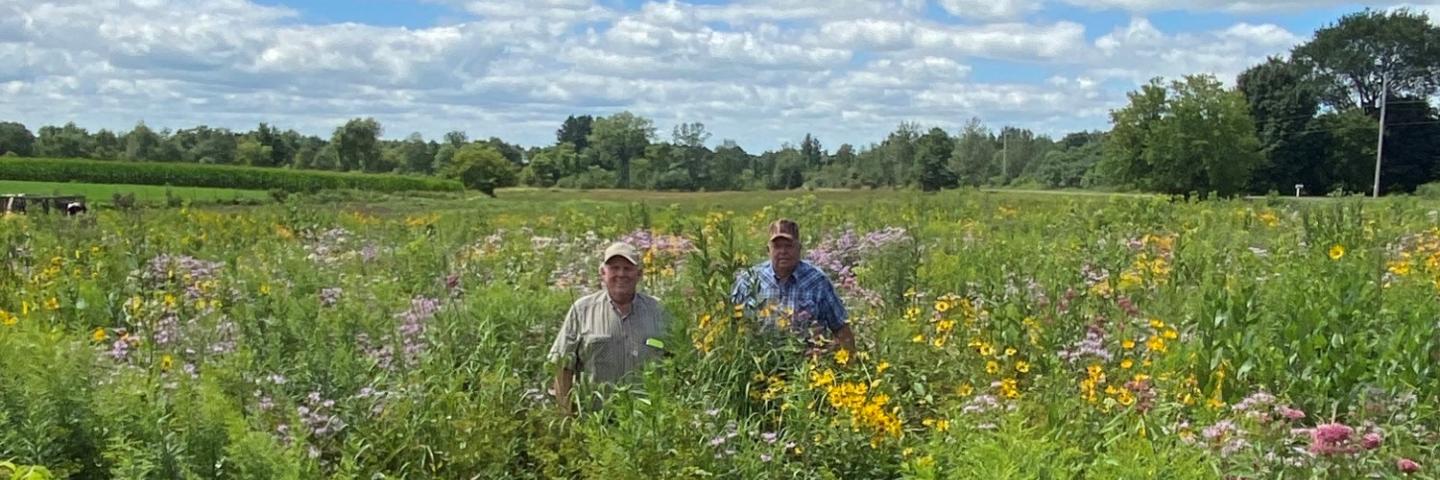Generational Conservation and an Educator’s Lasting Impact

Brothers, Bill and Tom Roth continue a farming legacy of tried-and-true conservation practices instilled by their father and nurtured by their college professor.
Background
Don, Bill and Tom Roth purchased their father’s Portage County 320-acre farm in 1973. When their father passed away from cancer later that year, the three brothers were thrown into farming full-time while also balancing student life at both North Central Technical College and Mid-State Technical College. Through their classes, they met Dr. Howard Larson, a UW-Madison professor and dairy researcher, who took them under his wing. To this day, the brothers continue to follow many of the practices Dr. Larson developed in the early 1970s, including not cutting alfalfa after the first of September and the professor’s feed ration guidelines. The farm has grown from 320 acres with 75 milk cows to 1260 acres with 160 milk cows. In 2009, Bill and Tom purchased Don’s portion of the farm and assumed full operation of Roth Golden Acres Farm.
Highlights
Bill and Tom have continued partnership with the U.S. Department of Agriculture’s Natural Resource Conservation Service (NRCS) and Farm Service Agency (FSA), following in their father’s footsteps, who installed grass waterways as far back as 1959. Their father was conservation-minded and instilled that mindset in Tom and Bill. Every field they own is surrounded by at least a two-row border of trees. A major motivator for their conservation practices is wildlife habitat. They saw their first deer on the farm in 1961, and they have been leaving standing corn every year for wildlife since. In 2002 and 2017, they enrolled and re-enrolled 74 acres of cropland into FSA’s Conservation Reserve Enhancement Program (CREP), which is a part of the Conservation Reserve Program (CRP), the country’s largest private-land conservation program financed by FSA with technical assistance provided by NRCS. These days, Roth Golden Acres Farm typically has up to 150 deer and dozens of turkeys that choose to winter on the property.
In addition to wildlife habitat improvements, the brothers began planting their fields exclusively with a no-till planter. They implemented a Nutrient Management Plan and use cover crop planting with cost-share program assistance through the Wood County Land and Water Conservation Department. Bill and Tom have seen how poor farming practices have affected the Mill Creek Watershed over the years.
“You better work with Mother Nature instead of against her,” Bill noted. By implementing their father’s tried-and-true grassed waterways practice previously established with help from NRCS, their affected fields no longer develop gullies. With consistent no-till and cover crop practices on applicable acres recommended in their conservation plan, the soil organic matter build up is allowing them to plant earlier in the season. In 2018, their applications for funding through two NRCS Conservation Stewardship Program (CSP) contracts were awarded, allowing them to seed just over two acres of pollinator habitat full of native warm season grasses and forbs and install a half-acre shallow wildlife scrape in the following years.
Future Plans
Roth Golden Acres Dairy Farm has made genuine and significant efforts to improve their land for farming and wildlife as they maintain a profitable working dairy business. They have applied for contract renewal and hope to continue to implement practices that benefit both their land and wildlife through the Conservation Stewardship Program.
Additional Information
Conservation Stewardship Program - Wisconsin
The Conservation Stewardship Program (CSP) can help you identify natural resource problems in your operation and provide technical and financial assistance to solve those problems or attain higher stewardship levels in an environmentally beneficial and cost-effective manner.
Learn More
